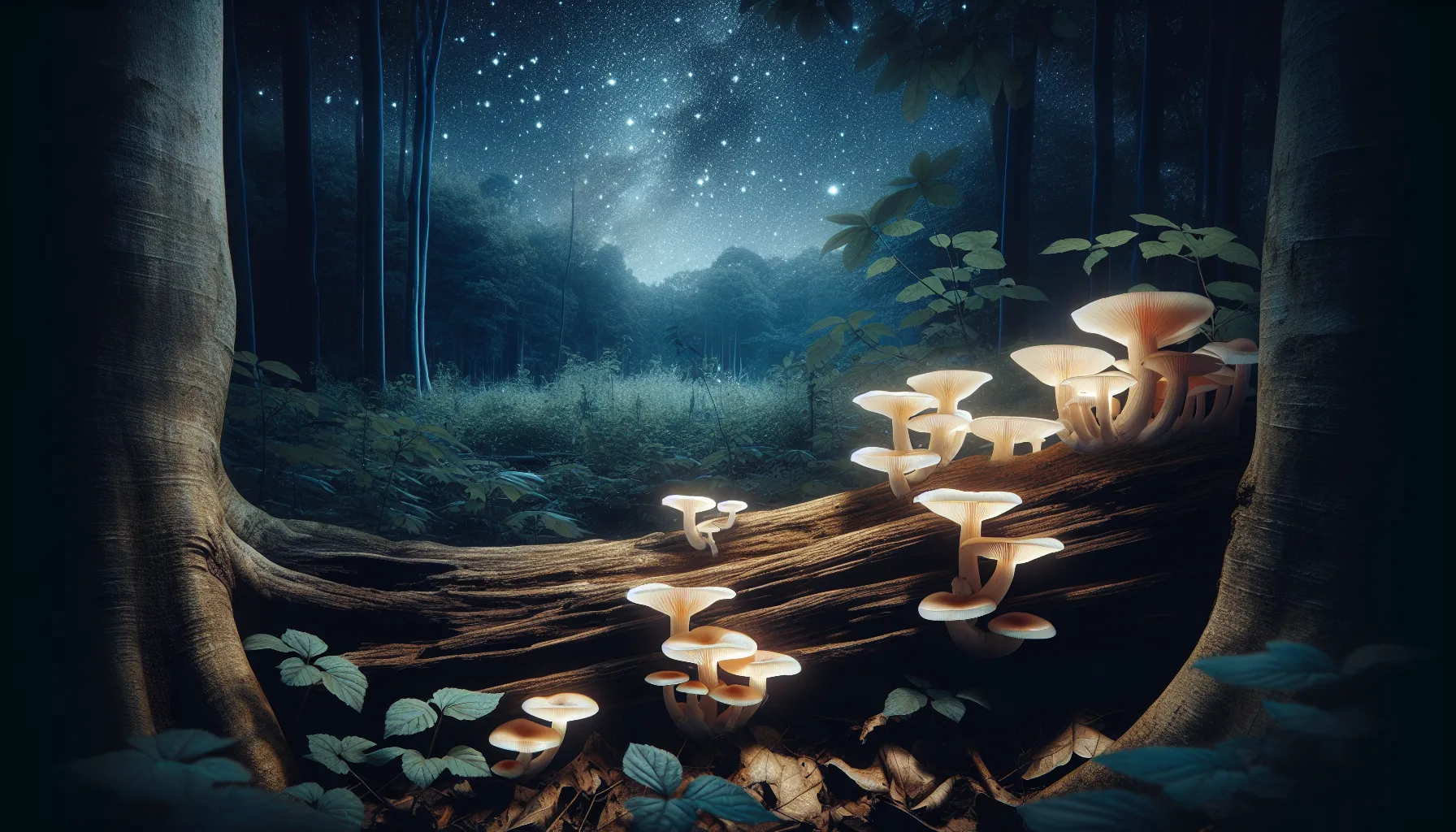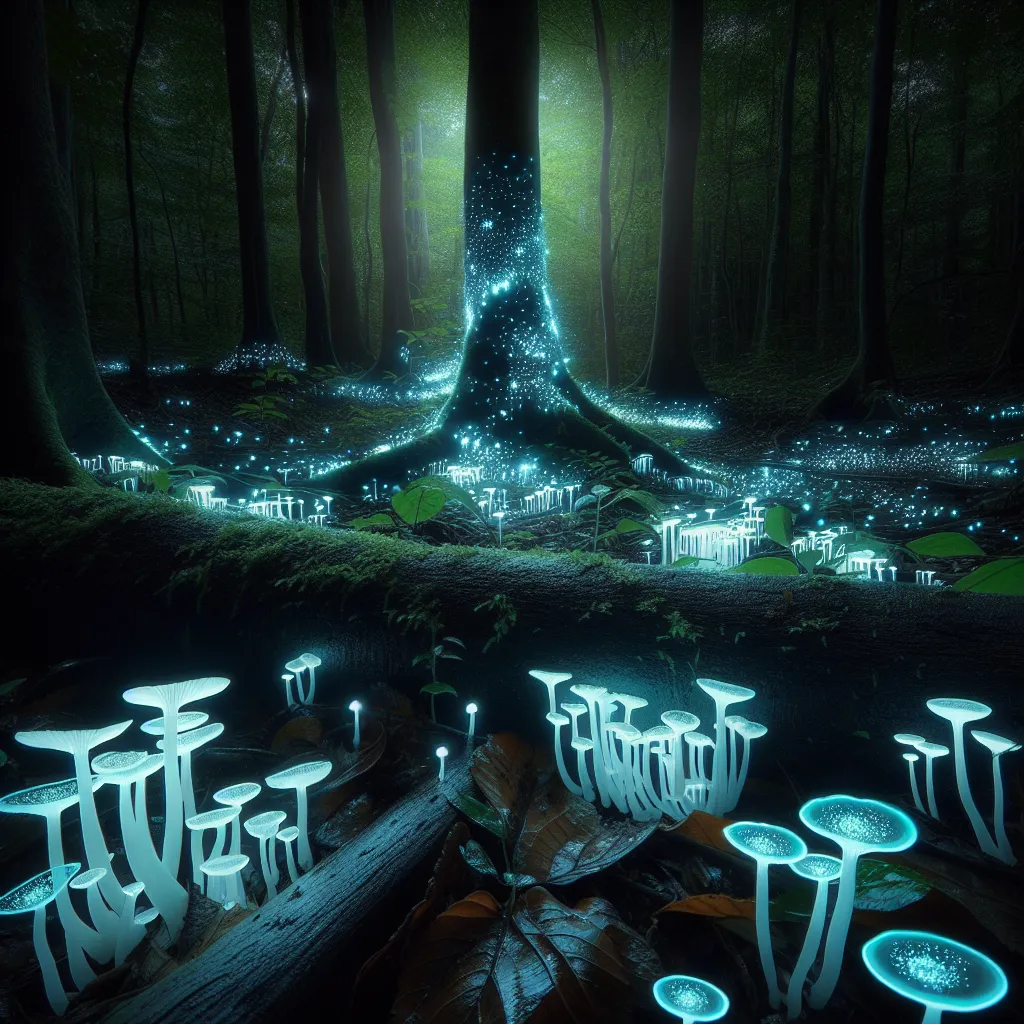Bioluminescent fungi stand as nature’s own nightlights, speckling forests with their eerie and captivating glow. These organisms are not just a wonder to behold but also a rich subject for scientific study and cultural fascination. This article delves into the luminous world of glow-in-the-dark mushrooms, examining their biology, types, ecological roles, cultural significance, and potential practical applications.
The Science Behind the Glow
The phenomenon of bioluminescence, where living organisms produce light, is one of nature’s most enchanting spectacles. While fireflies and deep-sea creatures are often the poster children for this biological marvel, a variety of fungi also possess this incredible ability.
What Causes Glowing Fungi?
Bioluminescence in fungi occurs when a compound called luciferin undergoes oxidation in the presence of the enzyme luciferase, resulting in the emission of light. This chemical reaction is similar across bioluminescent organisms, but the actual molecules involved can differ.
Luciferin and Luciferase
In fungi, luciferin is a small organic molecule, distinct from its counterparts in other organisms. The precise structure of fungal luciferin is still under investigation, but it is known to produce light when reacting with oxygen. The enzyme luciferase acts as a catalyst in this reaction, with different species of fungi having distinct variants of this enzyme, classified within the oxidoreductases group.
Factors Influencing the Glow
The brightness and longevity of fungal bioluminescence are influenced by several factors, including environmental conditions (such as temperature and humidity), the age of the fungus, and the availability of luciferin and luciferase.
For a deeper dive into the biochemistry of fungal bioluminescence, The Mycology Society provides detailed resources on the subject.
Types of Bioluminescent Fungi
Over 75 known species of bioluminescent mushrooms are scattered across the globe, each with its unique charm. Here are some notable examples:
Omphalotus olearius (Jack O’Lantern Mushroom)
This mushroom is notorious for its bright orange color and vibrant glow. It is primarily found in North America and Europe and grows on decaying wood. Despite its inviting appearance, it is toxic and should not be consumed.
Panellus stipticus (Bitter Oyster Mushroom)
The Bitter Oyster Mushroom grows on dead or decaying wood of deciduous trees. It has a distinctive kidney-shaped cap and emits a subtle greenish glow from its gills.

Mycena chlorophos (Glowing Mycena)
Found in subtropical Asia and the Pacific region, the Glowing Mycena is known for its intense brightness. The cap, stem, and even the tiny hairs on the stem emit a vivid greenish light.
For an extensive list of bioluminescent fungi, the Wikipedia’s compilation offers a comprehensive catalog of species with their descriptions.
Ecological Role of Bioluminescent Fungi
Beyond their visual allure, these fungi serve crucial ecological functions. They contribute to nutrient cycling by decomposing organic material, thus releasing nutrients back into the soil. Moreover, their glow is hypothesized to attract insects, aiding in spore dispersal and thus promoting genetic diversity and colonization of new environments.
Cultural and Folklore Significance
The mysterious glow of these fungi has inspired countless myths and tales, where they are often associated with fairies, spirits, and supernatural occurrences. In North America, the term “foxfire” has been historically used to describe the phenomenon.
Artists and writers have also found muses in these luminous mushrooms, using them to symbolize magic and the unknown in various creative works. The Mycological Society of America often explores the intersection of fungi and culture, providing insights into how these organisms have influenced human history and creativity.

Practical Applications
The potential applications of bioluminescent fungi are vast and varied. They are used in scientific research as bioindicators and in the development of biosensors. The possibility of creating biodegradable light sources is also being explored, with the aim of developing sustainable lighting solutions.
In medicine, bioluminescent proteins may aid in diagnostics and drug delivery. The unique chemistry of these fungi may also lead to new pharmaceutical discoveries.
Finding Bioluminescent Fungi
For those intrigued by the prospect of witnessing these glowing organisms, they can typically be found in moist, wooded areas, often attached to decaying wood. They are most visible at night and seem to prefer certain seasons or climates. When searching for these fungi, it is paramount to practice responsible exploration to ensure their habitats remain undisturbed.
To learn more about responsible foraging and identification of bioluminescent fungi, consider visiting Snowman Studios, where you can find tips from seasoned nature photographers and mycologists.
Conclusion
Bioluminescent fungi are a blend of beauty, science, and mystery. They not only light up the night with their alluring glow but also play significant roles in the ecosystems they inhabit. Their influence extends into the realms of culture, mythology, and potential technological innovations. As we continue to unearth the secrets of these glowing marvels, our appreciation for the interconnectedness of life deepens, reminding us of the untold stories that lie beneath the forest canopy. The study and preservation of these fungi are not just for the enrichment of our knowledge but also for the future generations who will inherit the wonders of our natural world.
